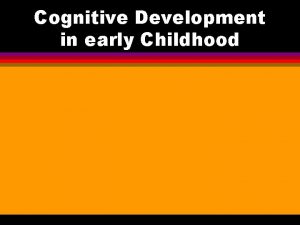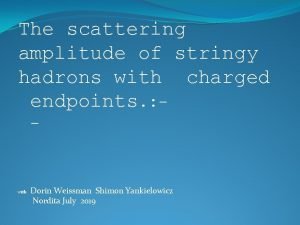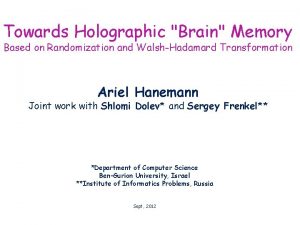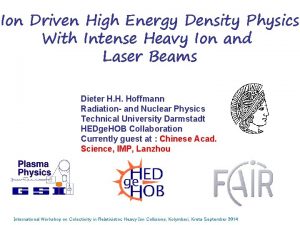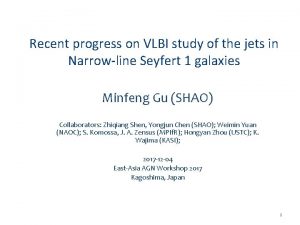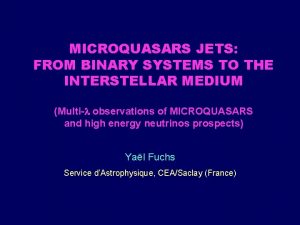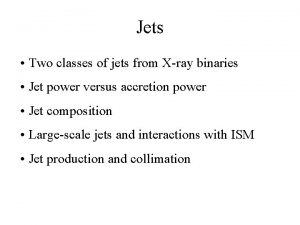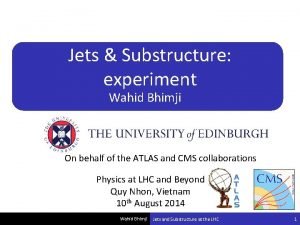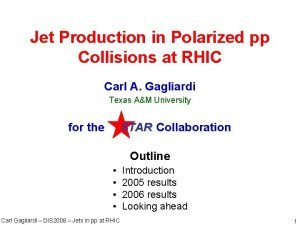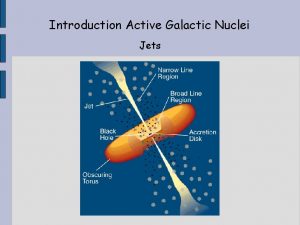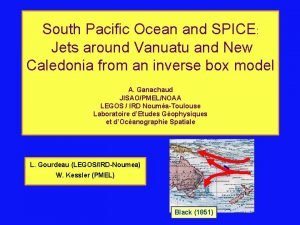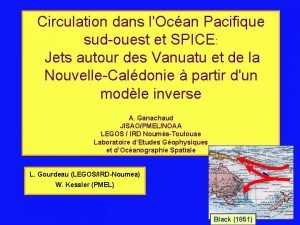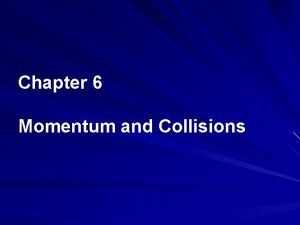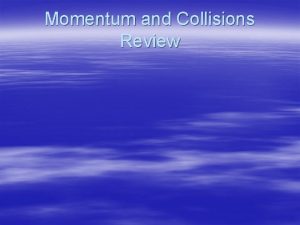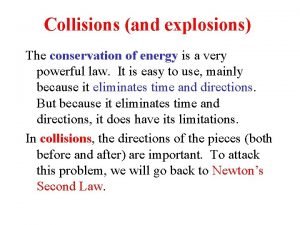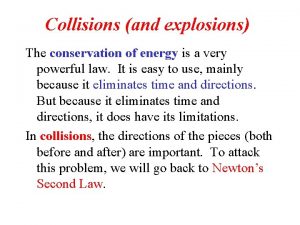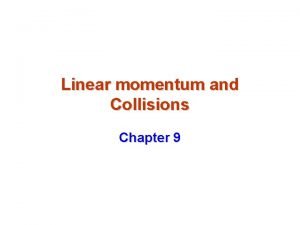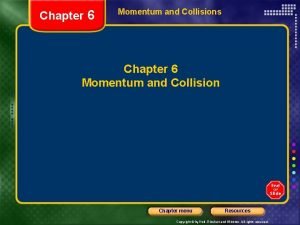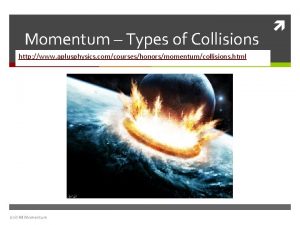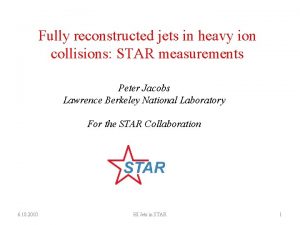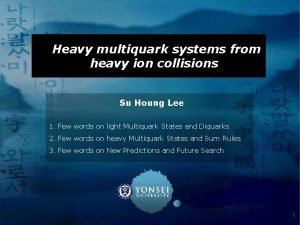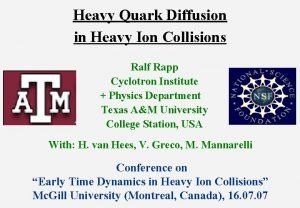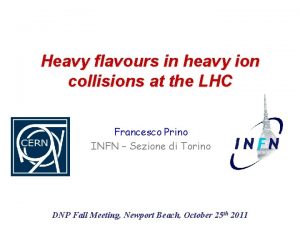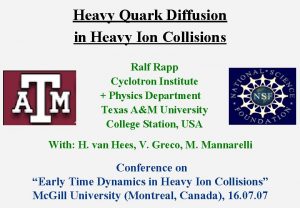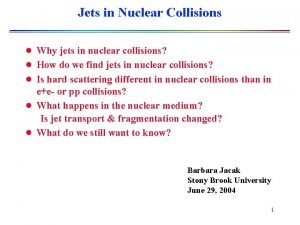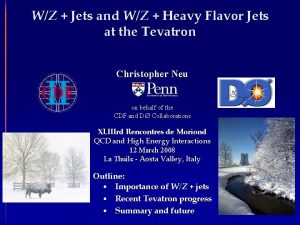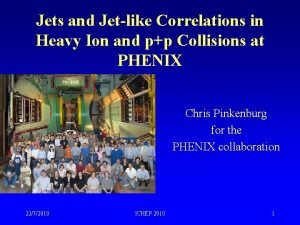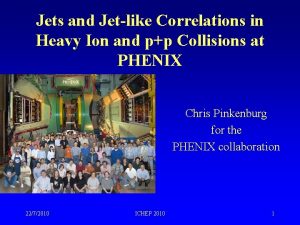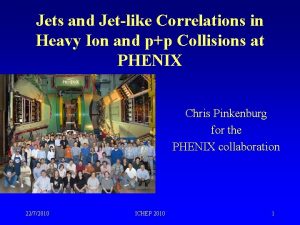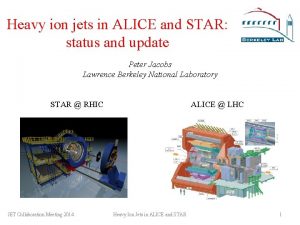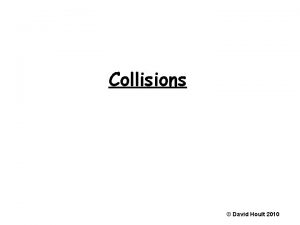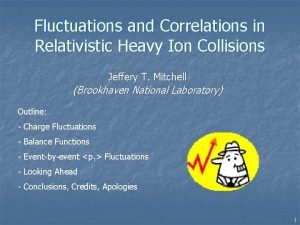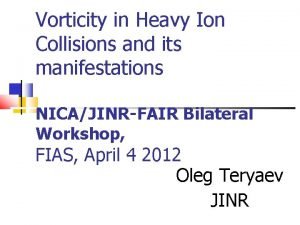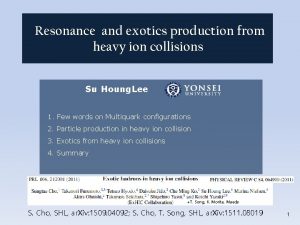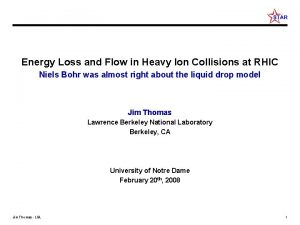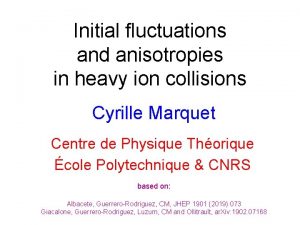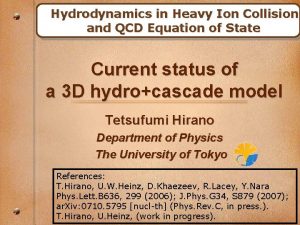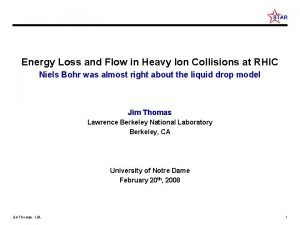RECENT HOLOGRAPHIC HEAVY ION COLLISIONS JETS AND HYDRODYNAMISATION



























- Slides: 27

RECENT HOLOGRAPHIC HEAVY ION COLLISIONS: JETS AND HYDRODYNAMISATION TOWARDS QUANTITATIVE RESULTS FROM HOLOGRAPHY Based on work with Krishna Rajagopal, Andrey Sadofyev, Jasmine Brewer and Saso Grozdanov References: 1501. 04952, 1602. 04187 (PRL), 1610. 08976 (slowed down by 1023) Wilke van der Schee Holography seminar, Oxford 28 February 2017

Wilke van der Schee, MIT OUTLINE Holography to model QCD • Ad. S/CFT: first principle non-perturbative QFT computations • Limitations: QCD(-like) theory with intermediate coupling is hard Two simple models • Colliding lumps of energy in super-Yang-Mills theory • Obtain early hydrodynamics + rapidity distribution • Finite coupling corrections • Shoot ensemble of jets through expanding and cooling s. QGP • Extract influence QGP on jet opening angle distribution • Time permitting: small systems • More refined models, more realistic phenomenology 2/24 An outlook

Wilke van der Schee, MIT KEY HEAVY ION PHYSICS: Surprising (? ): quark-gluon plasma is a fluid! • An almost ideal fluid Experiment: billions of Pb or Au collisions • Each has ~2000(0) particles at RHIC (LHC) • Study correlations, v 2, but also v 3 etc • very constraining data set! Still lot of theoretical uncertainty 3/24 • Initial stage (!), viscosity, jet observables

Wilke van der Schee, MIT/Utrecht STANDARD MODEL OF HEAVY ION COLLISIONS Initial stage goes from weak to strong coupling Hydrodynamisation: the process of far-from-equilibrium hydro Rapid longitudinal expansion means much later isotropisation Much progress on timescale: weak (kinetic) and at finite coupling Also important: resulting temperature profile and pre-flow 4/17 • • L. Keegan, A. Kurkela, P. Romatschke, WS and Y. Zhu, Weak and strong coupling equilibration in nonabelian gauge theories (2015)

Wilke van der Schee, MIT ADS/CFT AND HOLOGRAPHY Exact equivalence between certain string theories and certain QFTs • String theory only simple in large Nc and infinite ’t Hooft coupling • Several examples known, but no known ‘real world’ QFT (yet? ) A typical strategy: start with `canonical’ example N =4 SYM • • Theory non-confining, but confining analogues exist Theory has 4 supersymmetries, but can be broken Requires large Nc, but 1/32 seems small from lattice QCD Infinite coupling strength (but QCD coupling runs only logarithmically…) Holography provides a unique perspective 5/24 • Only way of computing far-from-equilibrium non-perturbative dynamics • Study rich dynamics of general strongly coupled theories

Wilke van der Schee, MIT ADS/CFT AND HOLOGRAPHY Heavy ion physics: a weak/strong coupling interplay? • A ‘hybrid’ approach: make a model inspired by strong and weak models • Bolder approach: strong coupling entirely • Qualitative/quantitative trends can inspire better modelling • In either approach some amount of fitting is required Viscosity is good example: • Canonical theory gives benchmark value • Qualitative insight: viscosity scales as entropy • Possible to compute corrections: 6/24 • Expected range: 0. 08 – 0. 12, link with weak coupling result?

Wilke van der Schee, MIT COLLISIONS AT INFINITELY STRONG COUPLING • Match longitudinal profile of energy density to nuclei Benchmark: 7/24 • Approximately homogeneous in transverse plane J. Casalderrey-Solana, M. P. Heller, D. Mateos and WS, From full stopping to transparency in a holographic model of heavy ion collision

Wilke van der Schee, MIT THERMALISATION/PRESSURES Pressures, energy starts at zero, grows (unique to holography? ) Thermalises very fast (hydro applies in perhaps 0. 02 fm/c) 8/24 • Thermalisation = relaxation non-hydro modes • Gradients + viscous corrections are big M. P. Heller, R. A. Janik and P. Witaszczyk, Hydrodynamic Gradient Expansion in Gauge Theory Plasmas (2013)

Wilke van der Schee, MIT RAPIDITY PROFILE + MUSIC Particle spectra in longitudinal direction: • Profile is about 30% too narrow WS and B. Schenke, Rapidity dependence in holographic heavy ion collisions (2015) ALICE, Bulk Properties of Pb-Pb collisions at √s. NN = 2. 76 Te. V measured by ALICE (2011) 9/24 • Rescaled initial energy density by factor 20

Wilke van der Schee, MIT A NEW QUANTITATIVE INSIGHT 10/24 • Collide shocks with energy and charge • Now collide neutral with charged shock • 41% of charge changes direction strong interactions J. Casalderrey-Solana, D. Mateos, WS and M. Triana, Holographic heavy ion collisions with baryon charge (2016)

Wilke van der Schee, MIT COLLISIONS AT FINITE COUPLING Leading order correction: small curvature squared • Not for N=4 SYM theory (but that’s also not what we want…) • Einstein-Gauss-Bonnet theory: • Reproduces weak-coupling expectations, i. e. Funny thing: evolution is just as simple as original 11/24 • Initial condition remains exact solution of EOM (for some L) • Nested scheme survives completely (with source terms) Yevgeny Kats and Pavel Petrov, Effect of curvature squared corrections in Ad. S on the viscosity of the dual gauge theory (2007)

Wilke van der Schee, MIT/Utrecht FINITE COUPLING CORRECTIONS Beyond pure perturbative treatment: • Insightful to plot ratio viscosity and relaxation time • Ratios ~0. 5 – 1. 5: steep at origin (previous slides), but quickly flattens • Leading order correction (curvature squared, as opposed to R 4) • Not N=4 SYM: Holographic dual not known explicitly (as with QCD) Seen to reproduce expectations of weaker coupling, i. e. larger viscosity 12/17 N=4 SYM (left) and Gauss-Bonnet gravity (right): Sašo Grozdanov, Nikolaos Kaplis and Andrei Starinets, From strong to weak coupling in holographic models of thermalization (2016) Tomas Andrade, Jorge Casalderrey-Solana and Andrej Ficnar, Holographic Isotropisation in Gauss-Bonnet Gravity (2016)

Wilke van der Schee, MIT COLLISIONS AT FINITE COUPLING - NARROW • Much more energy on lightcone (more transparent, less stopping) • Energy in plasma flatter (will get to rapidity) 13/24 • Results presented for, i. e (solid) • Initial condition constructed such that energy is the same

Wilke van der Schee, MIT COLLISIONS AT FINITE COUPLING - RAPIDITY • Initial rapidity shape differs from Gaussian Wide Almost entirely by hydro + less pile-up: First lower energies + wider Viscosity: lower transverse pressure, more entropy 14/24 Narrow Wider and lower initially (energy on lightcone not shown) Later similar (time 3), then more entropy, similar width

15/52 JETS IN QGP Wilke van der Schee, MIT CMS PAPER EXO-12 -059

16 Olga Evdokimov, presentation Quark Matter 2015, CMS-PAS HIN-15 -011

Wilke van der Schee, MIT MATCHING BOTH JET ENERGY AND JET WIDTH Initial conditions in literature: minimize energy loss Would like to mimic distribution of real QCD jets • Extra motivation: how is distribution affected by QGP? • Take from p. QCD (compares well with PYTHIA) Link jet width to Ad. S angle A. J. Larkoski, S. Marzani, G. Soyez, J. Thaler, Soft drop (2014) 17/24 zi: fraction of jet energy qij: angle between particle i and j R: jet radius parameter

FIT VACUUM JET SHAPES Wilke van der Schee, MIT Try a few string profiles to obtain angular pattern in vacuum: Endpoint angle goes down at angle Extract energy density per angle Compute energy flow around jet axis Extract jet shape in Ad. S 5. We know can construct an ensemble of strings in good agreement with vacuum QCD 18/24 1. 2. 3. 4.

RESULTS Wilke van der Schee, MIT Shooting about 50. 000 jets through plasma Used Naïve QCD estimate gives 19/24 b: parameter multiplying temperature (simple profile in back up slide) K. Rajagopal, A. Sadofyev and WS, Evolution of the jet opening angle distribution in holographic plasma (2016)

JET SHAPE MODIFICATION Wilke van der Schee, MIT Shooting about 50. 000 jets through plasma Reproduces data qualitatively close to jet radius 20/24 Larger radii need inclusion of back reaction Jasmine Brewer, Krishna Rajagopal, Andrey Sadofyev and WS, to appear

FIRST EFFECT: JETS WIDEN Wilke van der Schee, MIT 21/24 Change of probability distributions of jet opening angle K. Rajagopal, A. Sadofyev and WS, Evolution of the jet opening angle distribution in holographic plasma (2016)

Wilke van der Schee, MIT SECOND EFFECT: NARROWER JETS • Energy distribution falls steeply (~E-6) • Wide jets lose (much) more energy 22/24 • selection bias on narrow jets ATLAS, Measurement of inclusive jet and dijet cross sections in proton-proton collisions at 7 Te. V centre-of-mass energy (2011)

ADVERTISEMENT: 3 RD JETS Wilke van der Schee, MIT • Three-jet events are essential in i. e. dijet distribution • Can also lead to interesting substructure within jet Idea: get distributions from p. QCD (Mad. Graph), make strings, etc. ATLAS, Measurement of inclusive jet and dijet cross sections in proton-proton collisions at 7 Te. V centre-of-mass energy (2011) 23/24 • Also important as background in jet shape

DISCUSSION Wilke van der Schee, MIT Holography and heavy ion collisions • Ad. S/CFT essential tool for insights in strongly coupled matter • Complementary with weak coupling modelling Qualitative lessons and quantitative modelling • • • Fast applicability of hydrodynamics Most of energy stopped at moderate rapidity, Gaussian shape Less stopping and broader rapidity profile at finite coupling Energy loss jet has crucial interplay with jet width Hydro in small systems feasible at strong coupling (left out) • More quantitative comparisons with experiment, perhaps fitting width rapidity spectrum etc • Improved models closer to QCD, include running coupling 24/24 Outlook

Wilke van der Schee, MIT TWO COMPUTATIONS FOR SMALL SYSTEMS A fluctuation in a thermal bath: • Hydro works within 0. 2 fm/c, for system of size 0. 5 fm. • Hydro found to work in a system with R ~ 1/T WS, Holographic thermalization with radial flow (2012) Paul Chesler, How big are the smallest drops of quark-gluon plasma? (2016) 25/24 A full-blown off-center `p-p collision’:

Wilke van der Schee, MIT AN ESTIMATE For p-Pb and p-p collisions only few particles produced • Naïve estimate: gives • Volume per rapidity: R 2 tini • When R > 1/T (and tini. T>1) then d. Nch/dy > 4 • Note that R increases faster than 1/T (t versus t 1/3) 26/24 • Hydro works better at later times • Flow requires time to develop, i. e. 4 is `optimistic’ estimate

Wilke van der Schee, MIT MORE SIMPLIFICATIONS Simple semi-analytic hydrodynamic temperature profile: (b measures Nch per S, given EOS) Neglect initial dynamics (1 fm/c) + hadronization + confinement • Distribute according to binary scaling and • Free parameter b: to get reasonably energy loss ((coupling) A. Ficnar, S. S. Gubser and M. Gyulassy, Shooting String Holography of Jet Quenching at RHIC and LHC (2013) 27/24 Start string at single point at boundary )
 Piaget preoperational stage
Piaget preoperational stage Holographic duality theory
Holographic duality theory Holographic data storage
Holographic data storage Holographic will
Holographic will Holographic brain theory
Holographic brain theory What does ratey stand for
What does ratey stand for Heavy ion
Heavy ion Black hole jets
Black hole jets Microquasars
Microquasars Jets
Jets Jets
Jets Jets
Jets Jets
Jets Spice jets
Spice jets Spice jets
Spice jets Ejemplo de fuerza ion ion
Ejemplo de fuerza ion ion Qumica
Qumica Uniones intramoleculares
Uniones intramoleculares London dispersion forces
London dispersion forces Elastic vs inelastic vs perfectly inelastic
Elastic vs inelastic vs perfectly inelastic Type of momentum
Type of momentum A moderate force will break an egg
A moderate force will break an egg Elastic collision.
Elastic collision. Collisions and explosions
Collisions and explosions Collisions
Collisions Conservation of momentum
Conservation of momentum Chapter 6 momentum
Chapter 6 momentum Types of collisions
Types of collisions
